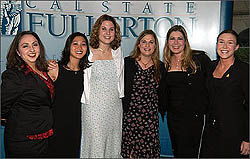| 
First-Year Teachers From Cal State
Fullerton
Perform Above CSU Average in Most Areas
April 15, 2004 :: No. 214
 |
| Graduates of the Blended Teacher
Education Program's Class of 2003. |
During the 2002-2003 school year, 709 Cal
State Fullerton students received preliminary teaching credentials.
And most of these first-year teachers are doing just fine
or better, according to recent survey results released by the California
State University. Statewide, CSU is the leader in educating California’s
teachers, training nearly 60 percent of all credentialed teachers
in California.
More than 2,300 school principals participated in
the CSU survey to determine the preparedness of first-year teachers
who completed CSU teacher preparation programs. Each assessed the
preparation of a specific teacher. Principals supervised these teachers
all year, observed them during instruction and discussed teaching
practices with them.
“Overall, we are very pleased with our scores,”
said L.Y. “Mickey” Hollis, acting associate dean of
Fullerton’s School of Education. “Of course, we are
always looking for ways to improve, and that’s the real benefit
of these surveys. It can help us focus our efforts on areas of programs
we wish to enhance.”
In most areas, Cal State Fullerton exceeded the CSU
average and continues to modify programs to enhance teacher preparation
in various areas.
“We are one of the major engines driving teacher
education in Orange County,” Hollis noted. “We have
one of the strongest programs in the state, and our recent data
indicates that not only are our students qualified, they generally
exceed expectations.
“I give a lot of credit to the top-notch faculty
who are teaching in our education school, as well as those teaching
the individual subjects,” he said. “First, the faculty
model good teaching methods. Secondly, they know how to motivate
and get their students excited about the subject areas. Finally,
we have wonderful working relationships with our partnership schools,
that is, schools where our students serve as interns or student
teachers.
“Many of these schools have beginning teacher
programs that our students find beneficial when they first begin
their teaching careers. These schools are scattered over 74 school
districts in Southern California,” he added, noting that 69
percent of CSUF students are involved in student teaching and 20
percent in internship programs.
“Without our partnership schools, we couldn’t
offer the quality of experiences,” said Hollis.
“Of course, I’d be remiss if I didn’t
also point out the high caliber of students in the teacher education
program,” he added. “We have high standards for students
in this program.”
Listed below are the percentage breakdowns from the
most recent CSU survey. These figures show the percentage of principals
who believe CSUF teachers are adequately to well-prepared in the
following topic areas, alongside CSU averages:
| • Teaching multiple subjects (elementary)
|
CSUF 84% — CSU 80% |
| |
|
| • Teaching single subjects (secondary education) |
CSUF 95% — CSU 92% |
| |
|
| • Teaching special education |
CSUF 83% — CSU 85% |
| |
|
| • Reading (K-8) |
CSUF 95 % — CSU 89% |
| |
|
| • Mathematics (K-8) |
CSUF 95 % — CSU 90% |
| |
|
| • Science (K-8) |
CSUF 82 % — CSU 67% |
| |
|
| • History (K-8) |
CSUF 83 % — CSU 64% |
| |
|
| • Visual and Performing Arts (K-8) |
CSUF 71 % — CSU 67% |
| |
|
| • Physical Education (K-8) |
CSUF 74 % — CSU 69% |
| |
|
| • Health (K-8) |
CSUF 77 % — CSU 67% |
In addition to topic areas, the survey also focused
on skills, including planning instruction and assessment. The percentages
reflect teachers rated as adequately to well-prepared:
| • Planning instruction |
CSUF 87 % — CSU 82% |
| |
|
| • Managing instruction |
CSUF 86 % — CSU 82% |
| |
|
| • Diversity and equity |
CSUF 80 % — CSU 77% |
| |
|
| • Responsive to training |
CSUF 87 % — CSU 81% |
| |
|
| • Assessment/Reflection |
CSUF 86 % — CSU 81% |
| |
|
| • Fieldwork in schools |
CSUF 84 % — CSU 79% |
Hollis sees these figures as benchmarks for enhancing
programs. For example, he would like to see better preparation among
teachers in the areas of visual and performing arts, health and
physical education. Hollis also hopes to enhance teacher training
when it comes to teaching students who are not native English speakers.
“With more than 50 different languages spoken
by students in Southern California schools, being able to work with
these culturally diverse student groups will become even more important,”
he said.
“Everyone focuses on reading and math, as they
should, because these are critical skills,” Hollis said. “However,
we also want our teachers to be well-prepared to teach in other
subject areas. With concerns about the increase in childhood obesity,
I think physical education will become more important to the general
public as well.”
According to Hollis, of the Cal State Fullerton students
who received their teaching credentials, 60 percent received their
bachelor’s degrees at Fullerton, while 12 percent received
their undergraduate degrees at another CSU campus. The remainder
came from schools other than those in the CSU system.
When they graduate from Cal State Fullerton, 46 percent
work in suburban schools (middle to upper income); 29 percent work
in metropolitan schools (middle to lower income); 23 percent work
in urban city schools (with a high population of low-income students)
and two percent in rural schools.
| Media Contacts: |
L. Y. “Mickey” Hollis,
acting associate dean, School of Education at 657-278-7350
or mhollis@fullerton.edu
Valerie Orleans, Public Affairs at 657-278-4540 or
vorleans@fullerton.edu
|
« back to University News
|